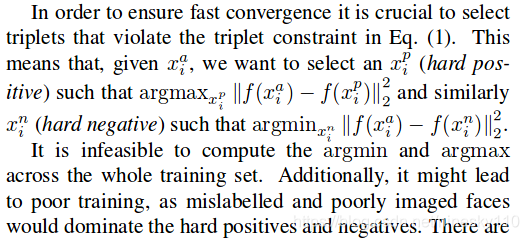facenet:triplet-loss理解與train_tripletloss.py程式碼理解
阿新 • • 發佈:2018-12-08
對於Facenet進行人臉特徵提取,演算法內容較為核心和比較難以理解的地方在於三元損失函式Triplet-loss。
 神經網路所要學習的目標是:使得Anchor到Positive的距離要比Anchor到Negative的距離要短(Anchor為一個樣本,Positive為與Anchor同類的樣本,Negative為與Anchor不同類的樣本)。通過學習使得類別內部的樣本距離大於不同類別樣本的距離即可。
神經網路所要學習的目標是:使得Anchor到Positive的距離要比Anchor到Negative的距離要短(Anchor為一個樣本,Positive為與Anchor同類的樣本,Negative為與Anchor不同類的樣本)。通過學習使得類別內部的樣本距離大於不同類別樣本的距離即可。
通過數學表示式如下所示,alpha為一個常數:

損失函式的定義如下所示:

利用隨機梯度下降法不斷讓loss變小,第一個正規化為(a,p)距離,第二個正規化為(a,n)距離,alpha為常數,因此可以理解為網路學習的過程就是使得類內距離變小,類見距離變大。
損失函式確定好之後如何在訓練時尋找anchor對應的negative樣本和positive樣本成為一個要著重考慮的問題。理論上講,我們應當選擇hard positive與hard negative,如下論文所示。

但是這種做法是不可行的,而且這種訓練方式可能無法達到優的效果。(個人理解:這種方法最麻煩的是需要在整個訓練集上找到anchor對應的negative,相當耗時)
因此作者的辦法是在訓練時,在一個batch上尋找negative,選擇的標準是滿足如下表達式:

這裡找到的negative樣本叫做semi-hard,意思是在batch的範圍內,只要(a,n)的距離大於(a,p)的距離即可。
以上便是對triplet-loss的理解。
對於如何訓練該模型,可以參考github上 https://github.com/davidsandberg/facenet 的實現(tf版本),以下我做了一些關於train_tripletloss.py的註釋,註釋為個人理解,有不對的地方請大家指正,其中有些部分參考( http://www.mamicode.com/info-detail-2096766.html ).
另外說明一點,程式實現找到negative:
在滿足(a,n)距離-(a,p)<alpha關係的基礎上,隨機選擇一個樣本作為negative。
"""Training a face recognizer with TensorFlow based on the FaceNet paper
FaceNet: A Unified Embedding for Face Recognition and Clustering: http://arxiv.org/abs/1503.03832
"""
# MIT License 